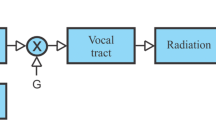Abstract
This paper explores the commonalities of the glottal source waves and vocal tract shapes among four speakers in emotional speech (vowel: /a/, neutral, joy, anger, and sadness) based on a source-filter model with the proposed precise estimation scheme. The results are as follows. When compared with the spectral tilts of glottal source waves of neutral, (1) those of anger and joy increased, and those of sadness decreased in the 200- to 700-Hz frequency range; (2) those of anger increased, but those of joy decreased, and those of sadness were the same as those of neutral in the 700- to 2000-Hz range; and (3) all spectral tilts had the same tendency over 2000 Hz. For front vocal tract shapes, the area function of anger was the largest, that of sadness was the smallest, and those of joy and neutral were in the middle.
Access this chapter
Tax calculation will be finalised at checkout
Purchases are for personal use only
Similar content being viewed by others
References
Schröder, M., Cowie, R., Douglas-Cowie, E., Westerdijk, M., Gielen, S.: Acoustic correlates of emotion dimensions in view of speech synthesis. In: 7th European Conference on Speech Communication and Technology (2001)
Hamada, Y., Elbarougy, R., Akagi, M.: A method for emotional speech synthesis based on the position of emotional state in Valence-Activation space. In: Asia-Pacific Signal and Information Processing Association, 2014 Annual Summit and Conference (APSIPA), pp. 1–7. IEEE Press (2014)
Li, X., Akagi, M.: Multilingual speech emotion recognition system based on a three-layer model. In: Interspeech, pp. 3608–3612 (2016)
Banse, R., Scherer, K.R.: Acoustic profiles in vocal emotion expression. J. Pers. Soc. Psychol. 70(3), 614–636 (1996)
Airas, M., Alku, P.: Emotions in vowel segments of continuous speech: analysis of the glottal flow using the normalised amplitude quotient. Phonetica 63(1), 26–46 (2006)
Gobl, C., Chasaide, A.N.: The role of voice quality in communicating emotion, mood and attitude. Speech Commun. 40(1–2), 189–212 (2003)
Kitamura, T.: Similarity of effects of emotions on the speech organ configuration with and without speaking. In: Interspeech, pp. 909–912, (2010)
Erickson, D., Zhu, C., Kawahara, S., Suemitsu, A.: Articulation, acoustics and perception of Mandarin Chinese Emotional Speech. Open Linguist. 2(1), 620–635 (2016)
Fant, G., Liljencrants, J., Lin, Q.-G.: A four-parameter model of glottal flow. in: STL-QPSR 1985, vol. 4, pp. 1–13 (1985)
Vincent, D., Rosec, O., Chonavel, T.: Estimation of LF glottal source parameters based on an ARX model. In: Interspeech, pp. 333–336 (2005)
Kane, J., Gobl, C.: Evaluation of automatic glottal source analysis. International Conference on Nonlinear Speech Processing, Springer, pp. 1–8 (2013)
Ohtsuka, T., Kasuya, H.: Aperiodicity control in ARX-based speech analysis-synthesis method. In: Seventh European Conference on Speech Communication and Technology, pp. 2267–2270 (2001)
Kawahara, H., Sakakibara, K.-I., Banno, H., Morise, M., Toda, T., Irino, T.: Aliasing-free implementation of discrete-time glottal source models and their applications to speech synthesis and F0 extractor evaluation. In: Signal and Information Processing Association Annual Summit and Conference (APSIPA), pp. 520–529. IEEE Press (2015)
Drugman, T., Bozkurt, B., Dutoit, T.: A comparative study of glottal source estimation techniques. Comput. Speech Lang. 26(1), 20–34 (2012)
Kane, J., Gobl, C.: Evaluation of automatic glottal source analysis. In: Drugman, T., Dutoit, T. (eds.) NOLISP 2013. LNCS (LNAI), vol. 7911, pp. 1–8. Springer, Heidelberg (2013). https://doi.org/10.1007/978-3-642-38847-7_1
Wakita, H.: Direct estimation of the vocal tract shape by inverse filtering of acoustic speech waveforms. IEEE Trans. Audio Electroacoust. 21(5), 417–427 (1973)
Schroder M., Cowie R., Douglas-Cowie E., Westerdijk M., Gielen S.C.: Acoustic correlates of emotion dimensions in view of speech synthesis. In: Proceedings of Interspeech 2001, pp. 87–90 (2001)
Acknowledgements
This study was supported by a Grant-in-Aid for Scientific Research (A) (No. 25240026) and China Scholarship Council (CSC).
Author information
Authors and Affiliations
Corresponding author
Editor information
Editors and Affiliations
Rights and permissions
Copyright information
© 2018 Springer Nature Switzerland AG
About this paper
Cite this paper
Li, Y., Sakakibara, KI., Morikawa, D., Akagi, M. (2018). Commonalities of Glottal Sources and Vocal Tract Shapes Among Speakers in Emotional Speech. In: Fang, Q., Dang, J., Perrier, P., Wei, J., Wang, L., Yan, N. (eds) Studies on Speech Production. ISSP 2017. Lecture Notes in Computer Science(), vol 10733. Springer, Cham. https://doi.org/10.1007/978-3-030-00126-1_3
Download citation
DOI: https://doi.org/10.1007/978-3-030-00126-1_3
Published:
Publisher Name: Springer, Cham
Print ISBN: 978-3-030-00125-4
Online ISBN: 978-3-030-00126-1
eBook Packages: Computer ScienceComputer Science (R0)




